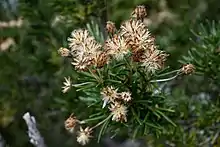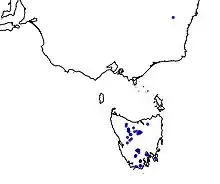| Olearia pinifolia | |
|---|---|
 | |
| In Mount Field National Park | |
 | |
| Close-up of fruit on kunanyi | |
| Scientific classification | |
| Kingdom: | Plantae |
| Clade: | Tracheophytes |
| Clade: | Angiosperms |
| Clade: | Eudicots |
| Clade: | Asterids |
| Order: | Asterales |
| Family: | Asteraceae |
| Genus: | Olearia |
| Species: | O. pinifolia |
| Binomial name | |
| Olearia pinifolia | |
 | |
| Olearia pinifolia distribution map | |
| Synonyms[1] | |
| |
Olearia pinifolia, commonly known as the pine-daisy, is a species of flowering plant in the family Asteraceae and is endemic to Tasmania. It is a shrub with rigid, linear, sharply-pointed leaves and white and yellow, daisy-like inflorescences.
Description
Olearia pinifolia is a rigid, bushy shrub that typically grows to a height of 1.5 m (4 ft 11 in) and has stout, woolly-hairy branches. The leaves are arranged alternately along the branches, crowded, narrowly linear and 25–38 mm (0.98–1.50 in) long. The leaves are rigid and sharply-pointed with the edges rolled under, giving the plant a pine-like appearance. They are glabrous on the upper surface and silky-hairy on the obsured lower surface. The heads or daisy-like "flowers" are mostly arranged singly on the end of a long peduncle and have a top-shaped involucre. Each "flower" has 8 to 10 white ray florets surrounding a larger number of yellow disc florets. The achenes are long, narrow and smooth, the pappus with bristles in several rows.[2][3][4]
Taxonomy
This daisy was first formally described in 1847 by Joseph Dalton Hooker who gave it the name Eurybia pinifolia in the London Journal of Botany from specimens collected by Ronald Campbell Gunn.[5][6] In 1867, George Bentham changed the name to Olearia pinifolia in Flora Australiensis.[7] The specific epithet (pinifolia) means "pine-leaved".[8]
Distribution and habitat
Olearia pinifolia is common in alpine or subalpine regions of Tasmania, including on Mount Wellington, Mount Dundas, Mount Sorell and Mount Field.[2][4]
Ecology
This species is known to be resistant to Phytophthora cinnamomi which can cause root rot. It may be susceptible to mealybug which feed on the juices of the plant, and may carry other diseases.[9]
Use in horticulture
Seeds can be collected from seeding Olearia pinifolia in the late summer to early autumn (January-March), when the plant releases the fluffy, white achenes. These can be collected and dried, and if sowed within a short time in a surface layer of loamy, low-phosphorus soil, can yield young O. pinifolia seedlings. Best sowing months in Tasmania are March-April and October-November, when conditions are mild and frosts rare. Germination occurs in two to five weeks after planting. Plants may also be propagated from cuttings taken from healthy, young specimens.[9]
References
- 1 2 "Olearia pinifolia". Australian Plant Census. Retrieved 3 July 2022.
- 1 2 Rodway, Leonard (1903). The Tasmanian Flora. Hobart: Tasmanian Government Printer. p. 75. Retrieved 3 July 2022.
- ↑ Bentham, George; von Mueller, Ferdinand (1867). Flora Australiensis. Vol. 3. London: Lovell Reeve & Co. pp. 471–472. Retrieved 3 July 2022.
- 1 2 Jordan, Greg. "Olearia pinifolia". University of Tasmania. Retrieved 3 July 2022.
- ↑ "Eurybia pinifolia". APNI. Retrieved 3 July 2022.
- ↑ Hooker, Joseph Dalton (1847). "Florae Tasmaniae Spicilegium: or, Contributions towards a Flora of Van Diemen's Land". London Journal of Botany. 6: 108–109. Retrieved 3 July 2022.
- ↑ "Olearia pinifolia". APNI. Retrieved 3 July 2022.
- ↑ Sharr, Francis Aubi; George, Alex (2019). Western Australian Plant Names and Their Meanings (3rd ed.). Kardinya, WA: Four Gables Press. p. 278. ISBN 9780958034180.
- 1 2 Smith, Andrew. "Olearia pinifolia". Understory Network. Retrieved 11 March 2021.